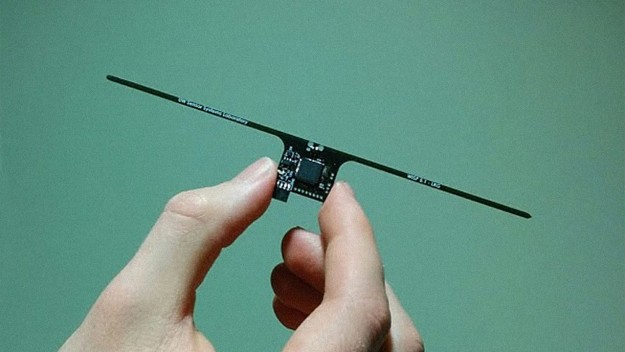
A tiny computer that has no battery, no discernible source of electricity, harvests all the power it needs from the ether and is the harbinger of both the “Internet of things” and the end of privacy as we know it. That’s the Wireless Identification and Sensing Platform (WISP) in a nutshell.
WISP harvests enough energy from radio waves emitted by a standard RFID transmitter to power its processor… a processor that’s nothing to shout about as it is about as potent as a Fitbit’s, according to its creators from the University of Washington and Delft University of Technology.
The miniature machine sidesteps many of the problems plaguing the preparation of old-school electronics, by shedding its greatest limiting factor: the need for a battery. A battery is extremely bulky, and regardless of its capacity, will eventually run out of power. WISP is by far the most powerful batteryless and wireless device ever created, never mind that it doesn’t allow us to play video games.
“But what’s the point? It has barely enough processing capability and power to run a few sensors,” I hear you say… well, running a few sensors is just enough for what its creators had in mind- and they’re just getting started with this tech.
“It’s not going to run a video game, but it can track sensor data, do some minimal processing tasks, and communicate with the outside world,” said one of the researchers at the University of Washington Sensor Lab, Aaron Parks.
Its ability to communicate with the outside world, coupled with its virtually limitless energy supply and a sophisticated sensory array, gives it a staggering amount of utility when the technology eventually comes of age. WISP can be embedded right about anywhere, and transmit data to and from a central location…for example, imagine a Fitbit that never needs charging, and downloads an update without being connected to anything. It monitors your step data, which it sends directly to the central database, which could communicate with your smart fridge and put it on lock-down. However, such sophistication isn’t possible…yet.
“So far WISP required cables to reprogramme it, nullifying the advantage of battery-less-ness. Therefore, we present Wisent, a protocol that allows WISP to be reprogrammed wirelessly,” said Dr Przemysław Pawełczak, assistant professor at the Embedded Software group at TU Delft in the Netherlands. “Our vision is to have truly wirelessly reprogrammable software-defined battery-less computers wherever and whenever we want.”
The researchers believe that WISP could be implanted into patients to monitor their health 24/7. It could be used in buildings to monitor structural integrity during an earthquake. It could monitor oil rigs, or crop conditions… the possibilities are limitless – as is the potential for abuse; if a rogue hacker broke into such a device, you’d lose all sorts of private data. Sticky-taping your laptop cam won’t do much when they know when you leave your house.
Then there’s the possibility of additional government surveillance. As with every leap forward in technology, its our responsibility to know where it can benefit us and where it can be abused.
Besides, do you really want the fridge to make the decisions in the house?
Sources: IB Times, Geek. FastCo
This article (The Tiny Batteryless Computer that Harvests Radio Waves for Power) is a free and open source. You have permission to republish this article under a Creative Commons license with attribution to the author(CoNN) and AnonHQ.com.





wonder how long it will take before someone tries to charge $$$ for that power
This article is hyped up to the max. Wireless scavengers capable of converting free floating EM waves into power is a very old and well known technology.
http://www.thelivingmoon.com/43ancients/02files/Ancient_Electricity_03.html